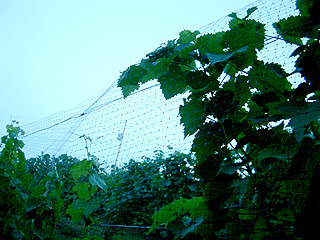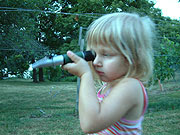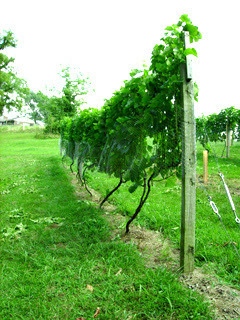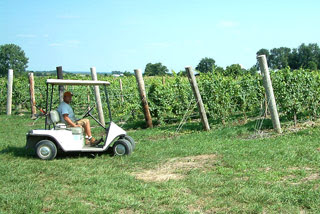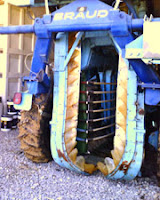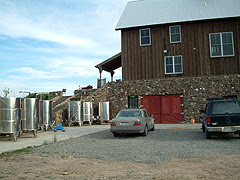 My last post of the year is another vineyard tip courtesy of Michael over at Amigoni Family Vineyards. He plants thermometers variously throughout his vineyard blocs to record variance in temperature of the mesoclimate. Because of slope, air flow, elevation, location of forested areas and water, etc., the temperature can vary greatly. Having a thermometer posted in each bloc, or even several for a larger bloc, can allow you to see that variance in action during a simple stroll through the vineyard.
My last post of the year is another vineyard tip courtesy of Michael over at Amigoni Family Vineyards. He plants thermometers variously throughout his vineyard blocs to record variance in temperature of the mesoclimate. Because of slope, air flow, elevation, location of forested areas and water, etc., the temperature can vary greatly. Having a thermometer posted in each bloc, or even several for a larger bloc, can allow you to see that variance in action during a simple stroll through the vineyard. Michael uses basic thermometers that also record the high and low temperature for a season by marking the extremes. This is especially useful here in Missouri where winter freezes can mean mortality for vinifera varietals. If you notice a temperature variance of several degrees in a winter low, say -10 degrees Fahrenheit at the top of the hill versus -13 in the middle of a slope, then you might want to plant your Chardonnay higher up and save your Cab Franc for the middle and maybe hybrids at the bottom, or avoid planting the bottom altogether. High temperatures are also an issue. Ours is a continental climate, which means we have strong extremes in the summer, too. We have hot growing conditions, and cultivars like Pinot Noir and Riesling are going to prefer the cooler mesoclimates within a vineyard as long as the winter lows won't wipe them out. You may find that the spots with the lowest lows don't necessarily have the lowest highs, and vice versa.
Michael uses basic thermometers that also record the high and low temperature for a season by marking the extremes. This is especially useful here in Missouri where winter freezes can mean mortality for vinifera varietals. If you notice a temperature variance of several degrees in a winter low, say -10 degrees Fahrenheit at the top of the hill versus -13 in the middle of a slope, then you might want to plant your Chardonnay higher up and save your Cab Franc for the middle and maybe hybrids at the bottom, or avoid planting the bottom altogether. High temperatures are also an issue. Ours is a continental climate, which means we have strong extremes in the summer, too. We have hot growing conditions, and cultivars like Pinot Noir and Riesling are going to prefer the cooler mesoclimates within a vineyard as long as the winter lows won't wipe them out. You may find that the spots with the lowest lows don't necessarily have the lowest highs, and vice versa.One note on the term mesoclimate. Most people incorrectly use the term microclimate when they mean mesoclimate. It makes sense, everyone knows what "micro" means, not so for "meso." But there are three climates that affect a vineyard. First, theres the regional climate, or macroclimate. That's the thing that we can't change. It's specific to an entire growing region, and it's what makes the Rhone the Rhone, Burgundy Burgundy, the true Sonoma Coast, Russian River Valley, etc. Then there's the mesoclimate, which is your variance in climate from bloc to bloc and row to row. We can affect that through careful planting of varietals, the direction of the row in relation to the sun and also in the winery by blending grapes from one mesoclimate within a vineyard with those from another. That's the term most connoisseurs use when they're talking about a specific vineyard's growing conditions and the style of the wine it makes. Finally, there's the microclimate, which, according to every viticulturist's good friend Dr. Richard Smart, is "the climate within and immediately surrounding a plant canopy." The temperature and humidity can be vastly different inside a dense canopy as compared to a few inches away on the outside. This is what we have the most control over through canopy management practices such as leaf removal, trellising, shoot positioning and thinning.
That's it for this year. It's been a productive year for me. We've purchased a property and vines are on order. What's more, it's a varietal with proven success in our area and one that area winemakers are excited about. See you next year.
-D











